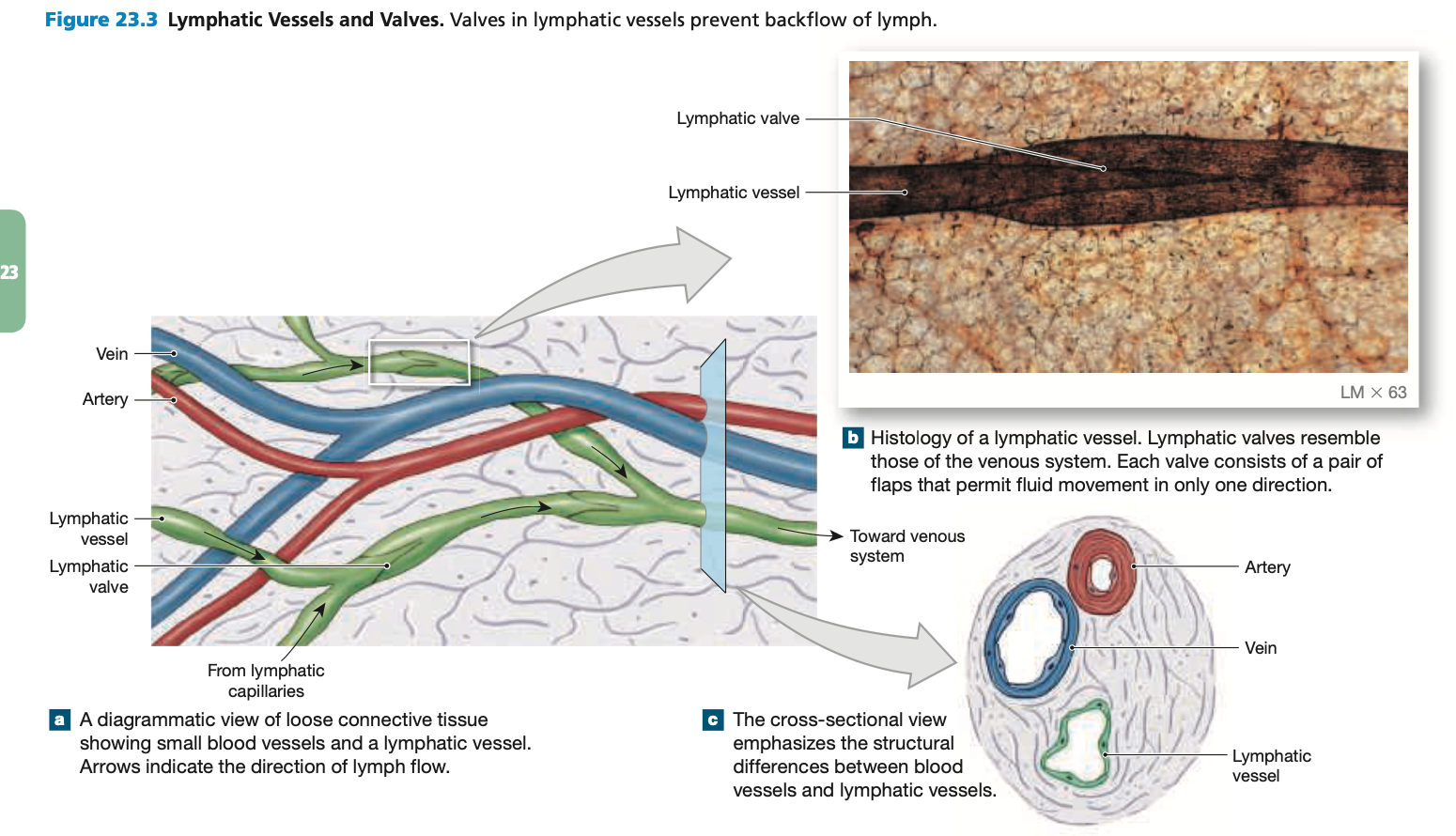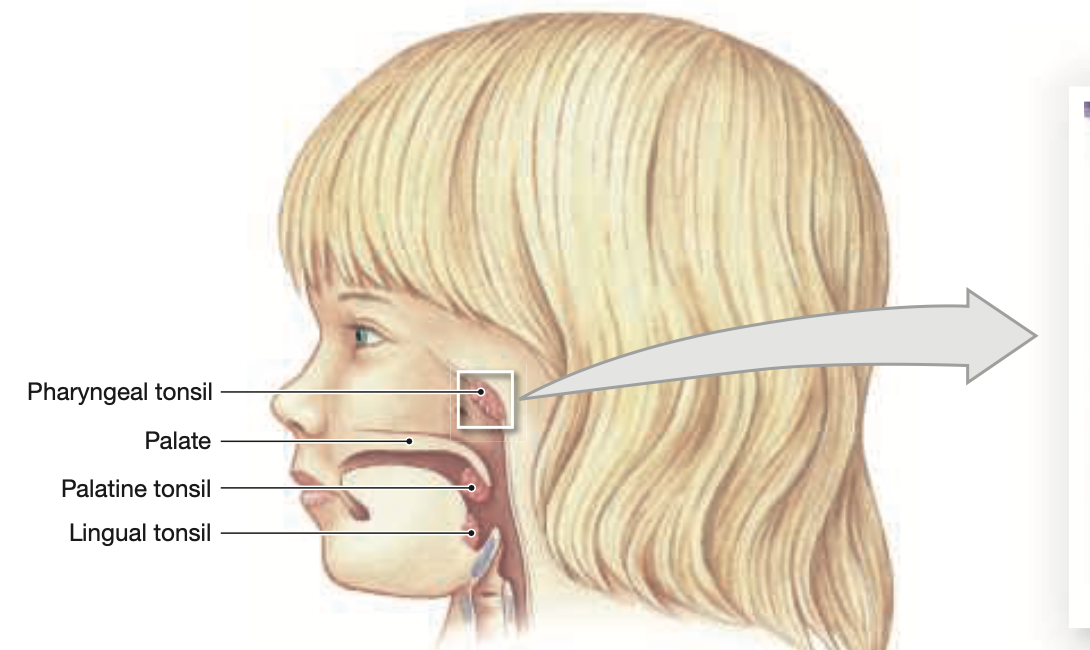Chapter 23: The Lymphatic System
Introduction to the Lymphatic System
An open system that originates in the periphery
Integral for body’s defense against pathogens (viruses, bacteria, microorganisms).
Overview of the Lymphatic System

Composed of:
Lymphatic vessels: transport lymph (like plasma but with fewer proteins).
Originate in peripheral tissues & deliver lymph to the venous system via the subclavian veins
Lymph: Fluid CT transported into the lymphatic vessels, consisting of:
Interstitial fluid— fluid that surrounds cells in tissue beds, similar to that of blood plasma but fewer proteins
Lymphocytes— Cells responsible for IR
Macrophages— Phagocytic cells that help eliminate pathogens and debris from the lymph.
Lymphatic organs & tissues: interconnected via lymphatic vessels.
Primary Lymphoid Organs: Thymus & Bone Marrow— Responsible for the differentiation of lymphocytes
T Cells, B Cells, & NK Cells
Secondary Lymphoid Organs: Lymph Nodes, Tonsils, and Mucosa-Associated Lymphoid Tissue (MALT) — sites where lymphocytes & B Cells reside and proliferate after exposure to pathogens.
Functions:
Produces, maintains, and distributes lymphocytes (immune cells).
Regulates blood volume and interstitial fluid composition.
Divided into primary (with stem cells) and secondary (with activated lymphocytes).
Structure of Lymphatic Vessels
Similar in structure and function to veins, but differ in several key ways:
Lymphatic capillaries have a larger luminal diameter
Thinner walls that lack a continuous basal lamina
Flat/irregular outline
Greater permeability due to overlapping endothelial cells
Lymphatic Capillaries:
Initiate lymph transport from peripheral tissues.
Endothelial cells overlap, creating a one-way valve to prevent backflow.
Larger Lymphatic Vessels:
Contain valves to prevent lymph backflow.
Major Collecting Vessels:
Superficial and Deep Lymphatics come from lymphatic capillaries.
The superficial and deep lymphatics converge to form Lymphatic Trunks— large lymphatic vessels that collect lymph from smaller lymphatic channels and drain it into the venous system—
Lumbar trunks
Intestinal trunks
Bronchomediastinal trunks
Subclavian trunks
Jugular trunks
Thoracic Duct: collects lymph lower body + left side above diaphragm.
Drains into L Subclavian Vein
Cisterna Chyli— Located just below the diaphragm, it is the begining of the Thoracic Duct, serving as a reservoir for lymph from the lower limbs and abdominal organs before it is transported to the thoracic duct.
Right Lymphatic Duct: collects lymph from right side above diaphragm.
Drains into R Subclavian Vein

Lymphocytes
Lymphocytes: The main cells of the lymphatic system, responsible for specific immunity
Types of Lymphocytes (Spotlight Figure 23.6):
T Cells (thymus-dependent): Directly attack pathogens
Cytotoxic T cells: destroy foreign/infected cells (cell-mediated immunity).
Regulatory T cells: moderate immune response.
Memory T cells: respond quickly to known antigens.
Helper T cells: stimulate T and B cell activity.
B Cells (bone marrow-derived): Indirectly attack pathogens (humoral immunity)
Differentiate into plasma cells (produce antibodies - immunoglobulins) and memory B cells (reactivate upon re-exposure to antigens).
Natural Killer (NK) Cells: attack virally infected and cancerous cells, providing immune surveillance.
Immune Response and Lymphocyte Dynamics
Immune Response Goal: Identify and eliminate pathogens, abnormal cells, toxins.
Antigens are processed by macrophages, which activate T cells.
Lymphocytes can replicate and are essential for hosts to combat various antigens (immunocompetence).
Distribution and Lifespan: B cell/T cell ratios fluctuate; lymphocytes have a long lifespan.
Lymphocytopoiesis: production of lymphocytes happens in red bone marrow, thymus, and peripheral lymphatic tissues.
Lymphatic Tissues
Made of connective tissues packed with lymphocytes.
Lymphatic Nodules: Aggregations of lymphocytes contained within a supporting meshwork of reticular fibers, which provide structural support while facilitating the immune response—
Mucous-Associates Lymphoid Tissue (MALT): The collection of lymphatic tissues within the epithelia of the digestive, respiratory, urinary, and reproductive systems
Tonsils: Large nodes found within wall of the pharynx—
Pharyngeal Tonsil— (Adenoid) an unpaired lymphoid tissue located at the roof of the nasopharynx
Palatine Tonsils— Paired lymphoid tissues located on either side of the oropharynx
Lingual Tonsils— Paired lymphoid tissue located deep to the mucosa at the base of the tongue
Aggregated lymphoid nodules: Found in the mucosa of the ileum (the last part of the small intestine), playing a crucial role in the immune system by monitoring intestinal bacteria and preventing the growth of pathogenic bacteria.

Key organs:
Lymph Nodes: encapsulated lymphatic tissue; contain T cells (paracortex) and B cells (cortex/medulla).
Cervical Lymph Nodes— Filter lymph originating in head & neck
Axillary Lymph Nodes—Filter lymph arriving at the trunk from upper limbs
Popliteal Lymph Nodes— Filter lymph arriving at the thigh from the lower leg
Inguinal Lymph Nodes— Filter lymph arriving at the trunk from the lower leg
Thoracic Lymph Nodes— Filter lymph from the lungs
Thymus: located in superior mediastinum, vital for T cell maturation (secretes thymic hormones).
Decreases in size post-puberty (involution).
Spleen: largest lymphatic tissue mass, vital for blood filtration (analogous to lymph node functions).
Contains red pulp (RBCs, macrophages) and white pulp (lymphocytes).
Aging and the Lymphatic System
Immune system effectiveness declines with age, leading to increased susceptibility to disease.
The thymus decreases in size as we age, leading to a lower production of T cells and a diminished immune response.